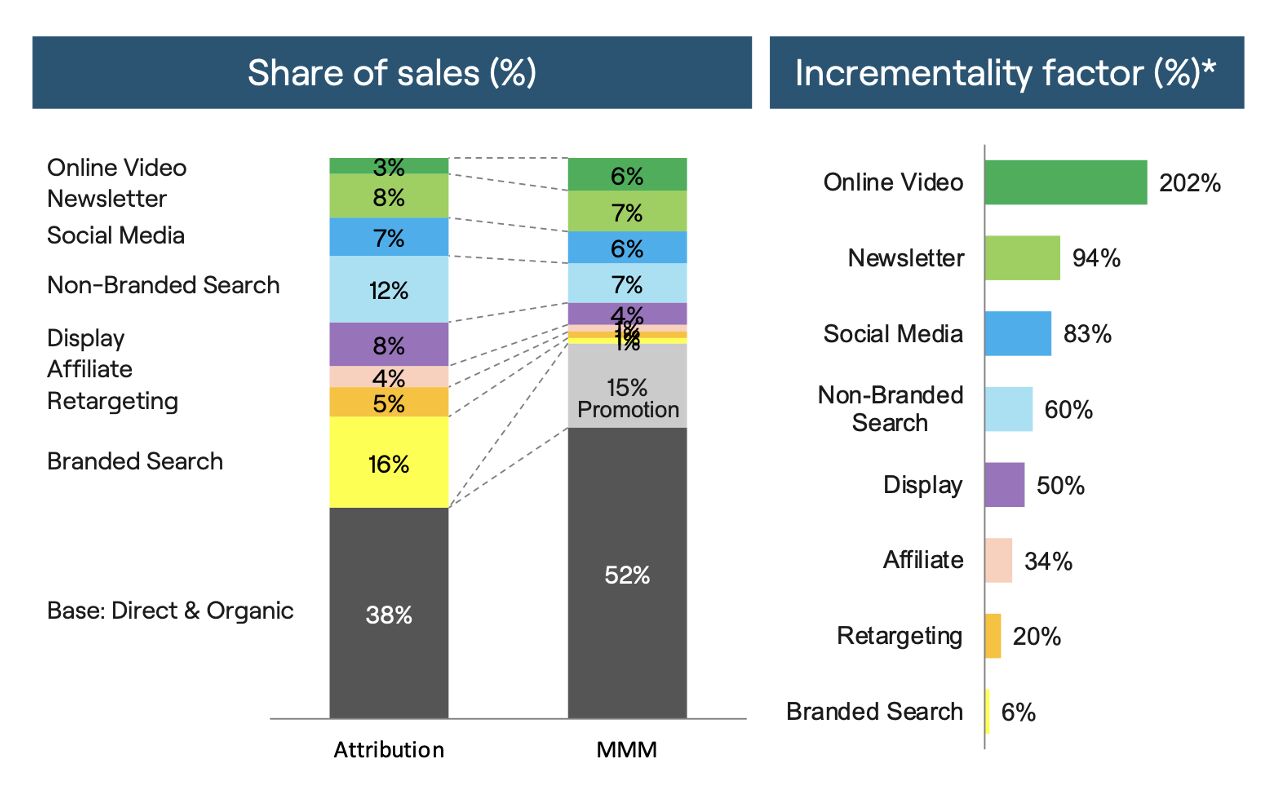Understanding Geo Lift Testing in Marketing: A Comprehensive Guide
This article explains how Geo Lift Testing helps to understand the effectiveness of marketing...
By: Johannes Fiegenbaum on 9/21/23 3:30 PM

Executives have always dreamed of a "single source of truth" to measure marketing performance and avoid wasting advertising budgets. Then came the wake-up call with iOS14, when Apple allowed users to disable tracking. In the post-iOS14 era, marketing attribution is about combining methods to calibrate your business model so you know which levers drive performance and make growth targets achievable.
In this article, I'll share insights and experiences from my Marketing Mix Modeling Service.
Marketing mix modelling (MMM) allows you to measure the results of your marketing and advertising campaigns and determine how different channels contribute to your goal (e.g., sales) based on econometric models of your historical data.
Marketing mix modelling is an established approach that was used and optimized by media companies long before digital marketing. However, as you can guess, this was manual, time-consuming, and therefore cost-intensive manual work. Even today, it is usually still agencies that collect data over long periods and convert it into models.
This breaks down the business metrics to distinguish between the contributions of marketing and promotional activities (incremental factors) and other factors (base factors). These factors that influence the marketing mix can be defined as follows:
Statistical analysis in media mix modelling uses multi-linear regression to determine the relationship between the dependent variable, e.g., sales or engagement, and the independent variables, e.g., advertising spend in the different channels.
For companies using marketing mix modelling, it is important to be critical in selecting the data they want to measure and the data they can measure. Data quality cannot be neglected, so companies need to spend time aggregating and cleaning data from internal databases, third-party sources, or both. Media mix models often use two to three years of data, allowing for factors such as seasonality.
A picture speaks more than a thousand words:

(Source: Sellforte.)
Marketing Mix Modelling therefore enables the following:
1. Better allocation of marketing budgets
MMM can be used to identify the most appropriate marketing channel (e.g., TV, online, print, radio, etc.) to achieve marketing objectives and maximize returns.
2. Better implementation of advertising campaigns
MMM can be used to forecast optimal spending levels for the marketing channels used to avoid saturation.
3. Testing business scenarios
With Marketing Mix Modelling, business metrics can be forecasted based on planned marketing activities and various business scenarios can be simulated, such as increasing spending by 10% in period y or the amount of spending required to achieve a 10% increase in sales, etc.
Additionally, attribution models often overestimate the relative effectiveness of direct-response channels and underestimate the impact of brand-building media like TV. Despite this, TV remains the medium that generates the most incremental sales. Attribution models, however, struggle to measure the effects of media like TV.
Another reason digital attribution distorts ROI is that it is short-term. A study by Meta confirms that advertising effects can last months or years, with the majority of the payback coming from these long-term effects. Attribution models rarely look beyond a few days.
Moreover, the true definition of attribution is "cause and effect". Often, campaign planners assign credits to a social media campaign and call it "attribution":

But this is only a very small part of the marketing mix, and true attribution is the incremental effect of:
4. Better risk management
Since MMM uses historical data, you can identify the risks and dependencies of marketing activities.
5. Transparency and accountability
MMM is not based on click-based attribution models or testing methods but on econometrics, ensuring that the results are robust and objective.
But only a quarter of all advertisers are utlising Marketing Mix Modeling, as per DMA:
.png?width=1844&height=1101&name=output%20(25).png)
Google Analytics 4 (GA4) is an improved version of Google Analytics that aims to better track user interactions across websites and apps. It allows for more flexible event tracking and integrates machine learning for better insights. However, GA4 has limitations in providing a holistic view of marketing performance:
In contrast, Marketing Mix Modeling offers a more comprehensive approach by analyzing a wider range of data and factors to measure the long-term impact of marketing activities.
Despite its advantages, MMM faces several challenges:
Despite these challenges, the benefits of MMM in providing a holistic view of marketing performance often outweigh the difficulties involved.
There are several ways to implement Marketing Mix Modeling:
Choosing the right implementation option depends on the specific needs and resources of your organization.
New SaaS solutions for Marketing Mix Modeling offer several advantages:
However, they may also have limitations in terms of customization and flexibility compared to bespoke models.
While lightweight MMM solutions like Robyn offer some benefits, they also have drawbacks:
It is important to weigh these disadvantages against the benefits when considering lightweight MMM solutions.
Hybrid attribution models combine elements of different attribution approaches, including MMM and digital attribution, to provide a more comprehensive view of marketing performance. Triangulation involves using multiple methods to validate and cross-check results, improving accuracy and reliability.
By integrating MMM with digital attribution and other methods, businesses can gain a more nuanced understanding of their marketing efforts and make more informed decisions.
Q: How long does it take to implement MMM?
A: The time required for implementation varies depending on factors such as the complexity of the model and the quality of data. It can take several weeks to several months to build and deploy a comprehensive MMM model.
Q: How can I ensure data quality for MMM?
A: Ensuring data quality involves thorough data collection, cleaning, and validation processes. It is essential to use reliable data sources and regularly review and update the data used in the model.
Q: Can MMM be used for all types of businesses?
A: MMM is versatile and can be used across various industries and business sizes. However, the effectiveness of the model depends on the availability and quality of data and the specific marketing activities of the business.
As an independent consultant with extensive experience in Marketing Mix Modeling (MMM), I am here to help you take your marketing strategy to the next level. Whether you need assistance with the implementation of MMM solutions, support in selecting the right tool, or a customized analysis for your company – I offer expert advice and tailored solutions that are aligned with your specific needs.
Let's work together on your successful marketing strategy! Contact me today for a non-binding conversation to find out how I can assist you. Visit my contact page to learn more about the possibilities of working together. I look forward to your inquiry!

A solo consultant supporting companies to shape the future and achieve long-term growth.
More about meThis article explains how Geo Lift Testing helps to understand the effectiveness of marketing...
Learn how to carry out marketing mix modeling with Cassandra. Ideal for entrepreneurs and start-ups...
Discover the best marketing tools for start-ups to optimize efficiency and automate processes. From...